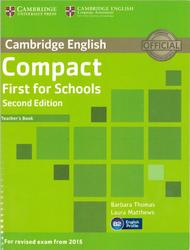This thesis proposes an integration of Paradigm Function Morphology (PFM) as the morphological component within the Lexical-Functional Grammar (LFG) architecture, applying the combined theoretical framework LFG-PFM to account for diachronic data. The theory is developed by application to two case studies from Portuguese involving mismatches between different levels of grammatical structure and resulting in divergence between varieties of the language. In each case, I give a new presentation of the Portuguese phenomena, which have not previously been treated in LFG or PFM.
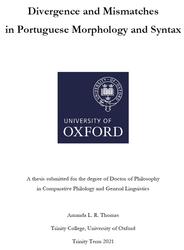
Advantages of LFG and justification for its use.
As we have already seen, one of the major features of LFG is its architecture involving separate modules to account for different facets of the grammar. This is a particular advantage for work that seeks to deal with phenomena that involve more than one aspect of linguistic structure. For example, this work considers interactions between purely morphological patterns and syntactic properties. In LFG, it is straightforward to separate out distinct changes and represent their interactions, without implying that changes in one module necessarily bring about changes in others.
More generally, the strictly modular approach implemented in LFG provides flexibility to accommodate new analyses. This is particularly visible in modules outside syntax, where alternative approaches to non-syntactic phenomena can be formulated and directly compared, without disrupting other modules of the grammar. These different approaches may involve new proposals regarding the structure of the architecture, or involve the structure of one module in particular. To take an example which is not considered elsewhere in this thesis, various different LFG approaches have been taken to account for the contribution of prosody. There are different proposals for the location of prosodic structure (p-structure) in the architecture, either projected from c-structure (Mycock 2006) or from discourse structure (O’Connor 2006). Some approaches integrate the prosodic hierarchy (Mycock 2006) while others reject this (Bogel 2005).
Contents.
List of Figures.
List of Tables.
List of Abbreviations.
Abstract.
Acknowledgements.
Chapter 1 Introduction.
1.1 Research questions.
1.2 Novel aspects of this research.
1.3 Brief introduction to Portuguese.
1.4 Structure of the thesis.
Chapter 2 Theoretical background.
2.1 Lexical-Functional Grammar.
2.1.1 Fundamentals of LFG.
2.1.2 Advantages of LFG and justification for its use.
2.2 Paradigm Function Morphology.
2.2.1 Fundamentals of PFM.
2.2.2 Advantages of PFM and justification for its use.
2.3 Combining LFG and PFM.
2.3.1 Lexemic entries.
2.3.2 Lexical entries.
2.3.3 M-entries and the morphological realisation relation ℛ.
2.3.4 The description function ????.
2.3.5 The relationship between f-features and m-features.
2.3.6 Categories in LFG and PFM.
2.4 Chapter summary.
Chapter 3 Applying LFG and PFM to Portuguese.
3.1 Analysis of Portuguese syntax and morphology.
3.1.1 Basics of Portuguese syntax in LFG-PFM.
3.1.2 Basics of Portuguese morphology in LFG-PFM.
3.2 Further aspects of LFG.
3.2.1 Semantic structure.
3.2.2 LFG and diachrony.
3.3 Extending PFM.
3.3.1 Taylor’s (2012) adaptations of PFM.
3.3.2 Generalized Paradigm Function Morphology (Spencer 2013).
3.3.3 PFM2 (Stump 2016).
3.3.4 Periphrasis in PFM (Biswas 2019).
3.4 Chapter summary.
Chapter 4 Portuguese double past participles in synchrony.
4.1 Past participles and their properties.
4.1.1 Functions of past participles in Portuguese.
4.1.2 Forms of past participles in Portuguese.
4.2 Lexical category of past participles.
4.2.1 Differentiation of verbs and adjectives.
4.2.2 Distinguishing the lexical category of Portuguese past participles.
4.3 The double past participle phenomenon.
4.3.1 Double past participles from a cross-linguistic perspective.
4.3.2 Double past participles in Portuguese.
4.3.3 Previous approaches to Portuguese double past participles.
4.3.4 Interim summary.
4.4 A formal LFG-PFM account of double past participles.
4.4.1 Morphological and syntactic views of double past participles.
4.4.2 Theoretical approaches to the lexical category of past participles.
4.4.3 The place of past participles in the verbal paradigm.
4.4.4 Lexical specification in the double past participle phenomenon.
4.4.5 PFM rules for past participles as complex stems.
4.4.6 Worked examples.
4.4.7 Number and gender agreement of the passive past participle.
4.4.8 Capturing syncretism between the two past participles.
4.4.9 Accounting for past participles in periphrases.
4.4.10 An integrated LFG-PFM account of the passive periphrasis.
4.5 Conclusions.
Chapter 5 Portuguese double past participles in diachrony.
5.1 Diachronic trajectories of double past participle forms.
5.1.1 Methodological questions in diachronic corpus work.
5.1.2 Past participles in Latin.
5.1.3 Double past participle forms from Latin to Portuguese.
5.1.4 Attestations of different forms in the history of Portuguese.
5.1.5 Divergence across varieties: double past participles in Brazilian Portuguese.
5.1.6 Summary of diachronic trajectories.
5.2 Analysing diachronic change.
5.2.1 The role of major inflection classes in the diachrony of the past participles.
5.2.2 Lexical specification in an LFG-PFM model of change.
5.2.3 Analogical change in the diachrony of Portuguese past participles.
5.3 PFM rules to account for diachrony.
5.3.1 Stem roots.
5.3.2 Stem formation rules and inflection classes.
5.3.3 Case studies: PFM rules for Brazilian Portuguese varieties.
5.3.4 Cross-paradigm diachronic processes: reanalysis of paradigm membership.
5.3.5 Integration with LFG: Lexemic entries.
5.4 Conclusions.
Chapter 6 Portuguese grammaticalised pronouns in diachrony.
6.1 Introduction to Portuguese pronouns and agreement mismatches.
6.1.1 Pronouns in Portuguese.
6.1.2 Agreement: mismatches, imposters and hybrids.
6.1.3 Beyond semantic and syntactic agreement: INDEX and CONCORD.
6.2 Use of grammaticalised pronouns in Portuguese.
6.2.1 Data: second person você and vocês.
6.2.2 Data: first person plural a gente.
6.2.3 Interim summary.
6.3 A formal LFG-PFM account of grammaticalised pronouns.
6.3.1 Relationship between nouns and pronouns in the formal framework.
6.3.2 PFM analysis of nouns and pronouns.
6.3.3 Mismatches between syntax and semantics and their representation in LFG.
6.3.4 Formal representation of grammatical features.
6.4 Worked formal representations.
6.4.1 Formal representations of second person singular pronouns.
6.4.2 Formal representations of second person plural pronouns.
6.4.3 Formal representations of first person plural pronouns.
6.4.4 Lexical and lexemic entries for inherited and grammaticalised pronouns.
6.4.5 PFM rules for pronouns.
6.5 Analysis: LFG-PFM insights into grammaticalised pronouns.
6.5.1 Adaptations to LFG representations.
6.5.2 Value of an LFG-PFM approach to mismatches.
6.5.3 Questions raised and areas for future research.
6.6 Conclusions.
Chapter 7 Conclusions from the thesis.
7.1 Key contributions of the thesis.
7.2 Directions for future research.
Appendices.
Appendix I Verbal paradigms: simplex forms.
Appendix II Periphrastic or compound verb forms.
Appendix III PFM rules and lexical data for Portuguese.
Appendix IV PFM rule blocks for Brazilian Portuguese past participles.
References.
Бесплатно скачать электронную книгу в удобном формате, смотреть и читать:
Скачать книгу Divergence and Mismatches in Portuguese Morphology and Syntax, Thomas L.R., 2021 - fileskachat.com, быстрое и бесплатное скачивание.
Скачать pdf
Ниже можно купить эту книгу, если она есть в продаже, и похожие книги по лучшей цене со скидкой с доставкой по всей России.Купить книги
Скачать - pdf - Яндекс.Диск.
Дата публикации:
Теги: учебник по английскому языку :: английский язык :: Thomas
Смотрите также учебники, книги и учебные материалы:
Следующие учебники и книги:
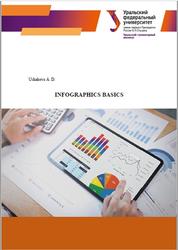 Infographics Basics, Ушакова А.Д., 2023 — Основная цель электронного учебного пособия Infographics Basics -научить студентов представлять результаты научных исследований и проектов ясно и наглядно при помощи … Книги по английскому языку
Infographics Basics, Ушакова А.Д., 2023 — Основная цель электронного учебного пособия Infographics Basics -научить студентов представлять результаты научных исследований и проектов ясно и наглядно при помощи … Книги по английскому языку Sign up to English New Edition, Teacher’s Book, Tosi M., 2020 — Sign Up to English New Edition is a fully updated and improved version of the best seller Sign Up to … Книги по английскому языку
Sign up to English New Edition, Teacher’s Book, Tosi M., 2020 — Sign Up to English New Edition is a fully updated and improved version of the best seller Sign Up to … Книги по английскому языку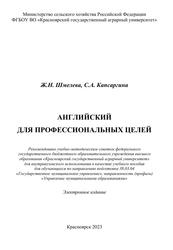 Английский для профессиональных целей, Шмелева Ж.Н., Капсаргина С.А., 2023 — Цель учебного пособия помочь будущим государственным служащим овладеть профессиональной лексикой, сформировать навыки устной речи, аудирования и письма для применения в … Книги по английскому языку
Английский для профессиональных целей, Шмелева Ж.Н., Капсаргина С.А., 2023 — Цель учебного пособия помочь будущим государственным служащим овладеть профессиональной лексикой, сформировать навыки устной речи, аудирования и письма для применения в … Книги по английскому языку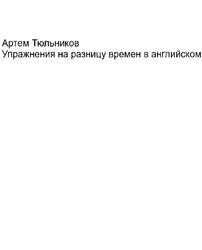 Упражнения на разницу времен в английском, Тюльников А. — Фрагмент из книги. А теперь сделайте эти предложения отрицательными и вопросительными. 1. Her car is not very expensive Is her … Книги по английскому языку
Упражнения на разницу времен в английском, Тюльников А. — Фрагмент из книги. А теперь сделайте эти предложения отрицательными и вопросительными. 1. Her car is not very expensive Is her … Книги по английскому языку
Предыдущие статьи:
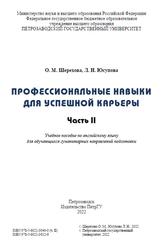 Профессиональные навыки для успешной карьеры, Часть 2, Шерехова О.М., Юсупова Л.Н., 2022 — Пособие содержит материалы профессиональной направленности, нацеленные на развитие коммуникативной инициативы у обучающихся вуза средствами иноязычного образования. Задания и упражнения имеют … Книги по английскому языку
Профессиональные навыки для успешной карьеры, Часть 2, Шерехова О.М., Юсупова Л.Н., 2022 — Пособие содержит материалы профессиональной направленности, нацеленные на развитие коммуникативной инициативы у обучающихся вуза средствами иноязычного образования. Задания и упражнения имеют … Книги по английскому языку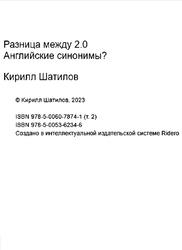 Разница между 2.0, Английские синонимы, Шатилов К., 2023 — Дорогие читатели и любители английского языка. Рад снова видеть вас на этих как всегда не совсем серьёзных страницах, посвящённых теме … Книги по английскому языку
Разница между 2.0, Английские синонимы, Шатилов К., 2023 — Дорогие читатели и любители английского языка. Рад снова видеть вас на этих как всегда не совсем серьёзных страницах, посвящённых теме … Книги по английскому языку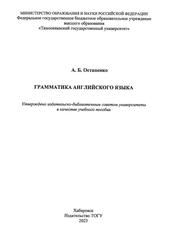 Грамматика английского языка, Учебное пособие, Остапенко А.Б., 2023 — Цель пособия - повышение уровня владения английским языком обучающихся в области инженерных, экономических и гуманитарных направлений университета. По shy;собие включает … Книги по английскому языку
Грамматика английского языка, Учебное пособие, Остапенко А.Б., 2023 — Цель пособия - повышение уровня владения английским языком обучающихся в области инженерных, экономических и гуманитарных направлений университета. По shy;собие включает … Книги по английскому языку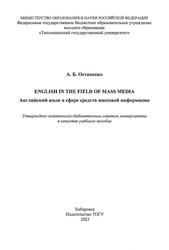 English in the field of Mass Media (Английский язык в сфере средств массовой информации), Учебное пособие, Остапенко А.Б., 2023 — Цель пособия - повышения уровня владения английским языком в сфере про shy;фессиональной коммуникации для обучающихся в области журналистики, рекламы и … Книги по английскому языку
English in the field of Mass Media (Английский язык в сфере средств массовой информации), Учебное пособие, Остапенко А.Б., 2023 — Цель пособия - повышения уровня владения английским языком в сфере про shy;фессиональной коммуникации для обучающихся в области журналистики, рекламы и … Книги по английскому языку




